Abstract
Highway exit ramps play a crucial role in ensuring the safe and efficient operation of road networks. As automated vehicles progressively integrate into highways, it is essential to investigate whether these exit ramps can accommodate the safe and efficient operation of heterogeneous traffic flows. This study constructed a basic simulation test using the SUMO simulation platform to analyze the adaptability of motorway exit ramps in a heterogeneous traffic environment. The simulation model incorporated the Krauss car-following model for the longitudinal dynamics of manual-driving vehicles, the ACC/CACC car-following model for automated vehicles, the LC2013 lane-changing model for manual-driving vehicles, and the game-theoretic lane-changing model for automated vehicles. The results reveal that in the absence of automated vehicles, the comprehensive cost is minimized with a deceleration lane length of 215 m, offering superior adaptability compared to the current standard of 180 m. As the proportion of automated vehicles gradually increases to surpass 40%, the rate of improvement in traffic flow, operational speed, and overall operational costs diminishes. Under these conditions, heterogeneous traffic flows exhibit limited adaptability to the existing road infrastructure. However, when the deceleration lane is extended to 200 m, the exit ramp shows optimal adaptability for heterogeneous traffic flows.
1. Introduction
As a critical component of motorway systems, exit ramps serve as a transitional facility for traffic flow conversion between motorways and lower-grade roads, playing a key role in the overall quality of traffic operations of motorway networks [1,2]. Within an exit ramp area, vehicles frequently engage in lane-changing and other behaviors, leading to interactions that increase traffic conflicts and disruptions [3,4]. These disturbances often result in traffic congestion and accidents, making exit ramps vital nodes that influence the operational efficiency of a motorway network [5]. In recent years, the advancement of artificial intelligence (AI) technologies, particularly in the realm of automated driving, has emerged as a promising solution to address these challenges [6,7]. Automated driving technology, which integrates AI, visual computing, and monitoring systems, enables the safe and automated control of motor vehicles and has significantly impacted the future of traffic management [8,9]. At present, vehicles equipped with varying levels of automation are gradually penetrating traditional road traffic environments, initiating a transition from a fully manual-driving system to one increasingly composed of automated vehicles [10,11]. This transition will unfold over an extended period, giving rise to a heterogeneous traffic flow composed of both manual and automated vehicles [12,13].
In response to the emergence of heterogeneous traffic flows composed of both manual-driving and automated vehicles, researchers worldwide have conducted studies in this area. Due to the difficulty of large-scale real-vehicle testing, most research on heterogeneous traffic flow relies on network simulation software and traffic simulation platforms [14,15]. Network simulation studies often use tools such as MATLAB [16] and cellular automata [17] to model traffic dynamics, yielding valuable insights. Arnah Bose employed cellular automata to simulate heterogeneous traffic flow and analyze the operational states of traffic at varying vehicle ratios [18]. Jiang et al. developed operational rules for automated vehicles within a cellular automata framework, demonstrating that automated vehicles could alleviate traffic congestion [19]. Yuan et al. explored the characteristics of heterogeneous traffic flows in mixed environments, incorporating both automated and manual-driving vehicles through simulation modeling [20]. Liu et al. also used cellular automata to examine the impact of automated vehicle penetration on traffic flow characteristics, such as accessibility and speed [21]. Additionally, studies using traffic simulation software have contributed significantly to this field. Erfan Aria et al. carried out simulations of automated vehicles through secondary developments of the VISSIM software, revealing that automated vehicles have a particularly positive impact in high-density traffic scenarios [22]. Recent studies by Gularte et al. [23] have highlighted the potential of V2X communication technologies in enhancing traffic efficiency and safety. Likewise, emerging research on machine learning applications in traffic simulation environments underscores their promise in optimizing traffic signal control and predictive modeling [24]. Furthermore, cooperative driving algorithms have attracted significant attention for their capability to improve traffic flow dynamics and mitigate congestion, demonstrating their potential in the advancement of intelligent transportation systems [25]. Eunbi Jeong conducted similar VISSIM-based simulations to assess two types of longitudinal control strategies for automated vehicles, highlighting their potential to enhance traffic safety through effective traffic management [26].
The microscopic traffic simulation software Simulation of Urban Mobility (SUMO) has been extensively utilized in studies of heterogeneous traffic flows [27,28]. Compared to traditional urban traffic simulation environments, SUMO, as a fully open-source platform, offers enhanced flexibility for researchers, allowing for more detailed simulations [29,30]. Moreover, it supports online adjustments through its remote control interface (TraCI), enabling vehicle-to-vehicle information interactions [31]. Song et al. employed SUMO and the Scene Suite simulation platforms to model traffic flows under various vehicle-to-vehicle (V2V) communications and ADAS-ACC (Adaptive Cruise Control) penetration rates, both individually and in combination [32]. Their findings indicate that different combinations of V2V and ADAS-ACC penetration rates could significantly improve road safety. Smith et al. used SUMO to modify vehicle-following models, simulating automated driving and demonstrating that the penetration of automated vehicles substantially increased road capacity and enhanced road safety [33]. Berrazouane et al. also utilized SUMO to develop a simulation model based on real-world motorway data, analyzing the impact of varying proportions of automated vehicles on traffic flow performance [34].
However, current research on the adaptability of motorway exit ramps under heterogeneous traffic flow conditions faces three primary challenges: (1) In terms of simulation methods for automated vehicles, existing studies predominantly rely on cellular automata, VISSIM, or modifications to car-following and lane-changing rules to simulate automated vehicles. There is a need for further research on how to utilize the fully open-source microscopic traffic simulation software SUMO to select appropriate car-following and lane-changing models, calibrate parameters for both manual and automated vehicles, and more accurately simulate the operational behaviors of automated vehicles. (2) While progress has been made in studying the impact of automated vehicles on the operation of heterogeneous traffic flows, the rapid advancement of automated driving technology necessitates a shift towards examining mixed heterogeneous traffic flows. This requires selecting key performance indicators to characterize the operational state of heterogeneous traffic flows, constructing a comprehensive evaluation model, and conducting an integrated assessment of these traffic dynamics. (3) Most current research on highway exit ramps focuses on traditional, manual-driving vehicle traffic flows. The adaptability of exit ramps to future mixed heterogeneous traffic flows, which will include a significant proportion of automated vehicles, remains underexplored and needs further investigation.
Therefore, as automated vehicles continue to penetrate traffic flows, the operation of current highway exit ramps will be impacted to some extent. With the emergence of heterogeneous traffic flows consisting of both automated and manual-driving vehicles, key questions remain: How will the operational quality of highway mainlines and ramp connections change? Which rules govern the interaction of heterogeneous traffic flows at exit ramps? And how does the adaptability of these exit ramps compare with and without automated vehicles? To address this, this paper focuses on the adaptability of highway exit ramps in the context of heterogeneous traffic flows. Based on an analysis of the traffic characteristics of exit-ramp road traffic, the open-source simulation software SUMO was used to model heterogeneous traffic flows. Key evaluation parameters were selected, and a comprehensive evaluation model was constructed to analyze the adaptability of a highway exit ramp under heterogeneous traffic conditions. The findings provide a solid foundation for future research on the adaptability of highway exit ramps in such environments, offering valuable insights and theoretical references for the design and operational management of highway exit ramps under heterogeneous traffic conditions. The proposed technological framework is illustrated in Figure 1. The remainder of this paper is structured as follows: Section 2 describes the process of data acquisition; Section 3 outlines the methodology of this study; Section 4 presents the simulation test design and an analysis of the results; and Section 5 concludes this study, summarizing key findings.
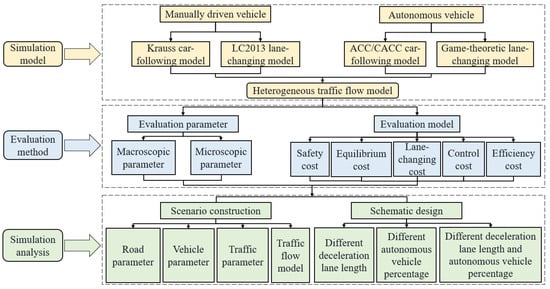
Figure 1.
Technological framework.
2. Data Acquisition
In this study, aerial photography and field investigations were used to investigate a high-speed exit ramp. Aerial video data, totaling approximately 10 to 15 min, were collected at eight distinct time intervals: 8:00–8:30, 8:30–9:00, 9:00–9:30, 9:30–10:00, 16:00–16:30, 16:30–17:00, 17:00–17:30, and 17:30–18:00. These intervals were chosen to capture variations in traffic patterns, with data converted into equivalent traffic volumes at 5 min intervals. The ramp under investigation is a two-lane direct exit ramp with auxiliary lanes. The main road consists of three lanes, designed for a speed of 120 km/h, while the exit ramp has two lanes. The ramp’s transition section is 100 m, the auxiliary lane is 350 m, and the speed-change lane measures 180 m. Observation sections were selected based on areas where vehicles were either about to change lanes or where lane changes were most frequent. These include the upstream section of the exit ramp (Section 1), the exit ramp separation point (Section 2), the middle section of the auxiliary lane (Section 3), the exit ramp diversion point (Section 4), and the downstream section of the exit ramp (Section 5). An overhead view of the surveyed exit ramp is shown in Figure 2. The specific sections and lanes observed are illustrated in Figure 3. The frequency distribution of vehicle speeds in each section is shown in Figure 4, and the average headway for each lane is presented in Figure 5, and the datasets are utilized as inputs for the methods detailed in Section 3.
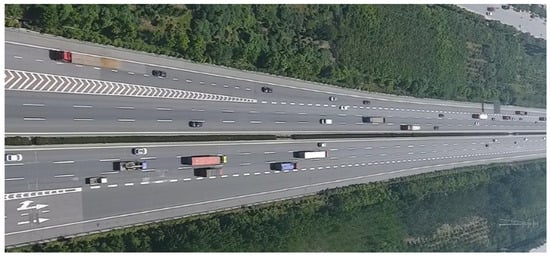
Figure 2.
Overhead view of the surveyed exit ramp.

Figure 3.
Observation section and lanes.
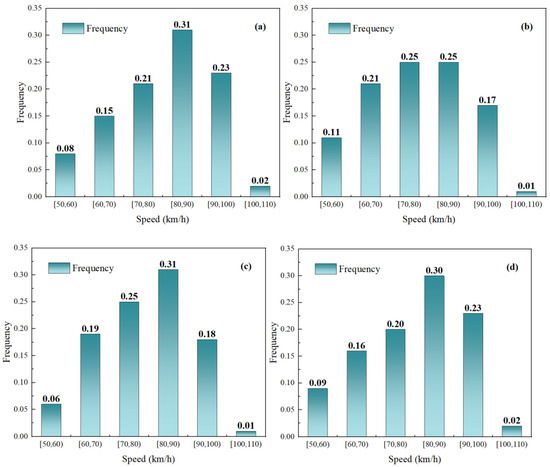
Figure 4.
Histogram of speed frequency distribution: (a) main lane 1; (b) main lane 2; (c) main lane 3; (d) auxiliary lane.
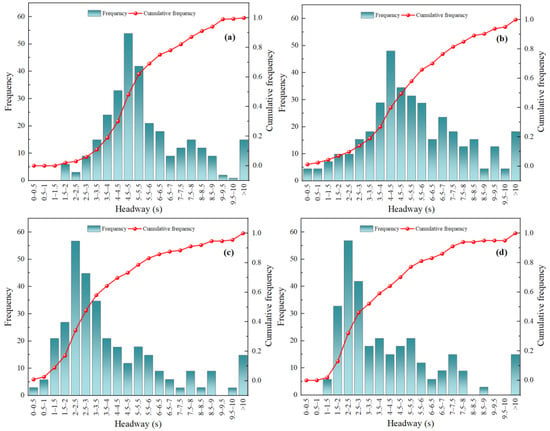
Figure 5.
Histogram of headway frequency: (a) main lane 1; (b) main lane 2; (c) main lane 3; (d) auxiliary lane.
In the highway exit ramp area, vehicle lane-changing behavior leads to a redistribution of headway distances. When the traffic volume is low, vehicle following behavior exhibits greater variability, resulting in a more dispersed headway distribution. Conversely, as the traffic volume approaches full capacity, following behavior becomes more constrained, leading to a more concentrated headway distribution. As shown in the figure above, over 90% of vehicles in the exit ramp area have a headway distribution within 10 s. In Section 3, it will be shown that there is minimal difference between lanes 1 and 2 of the main road, where 50% of vehicles have a headway within 0–5 s, and 95% fall within 0–10 s. Compared to these lanes, vehicles in lane 3 of the main road and the auxiliary lanes exhibit shorter headway distances, with 70% of vehicles having a headway within 0–5 s and 95% within 0–10 s. The variability in headway spacing between inner and outer lanes is influenced by two key factors. First, outer lanes are more affected by lane-changing behavior. Second, different lanes serve distinct functions within the mainline road, leading to variations in vehicle-following behavior across lanes.
Most of the exit ramps observed in this paper are mandatory lane changes, and the lane-change trajectories are mainly from the mainline road to the ramp. Data comprising 200 lane changes were selected for observation, as shown in Figure 6.
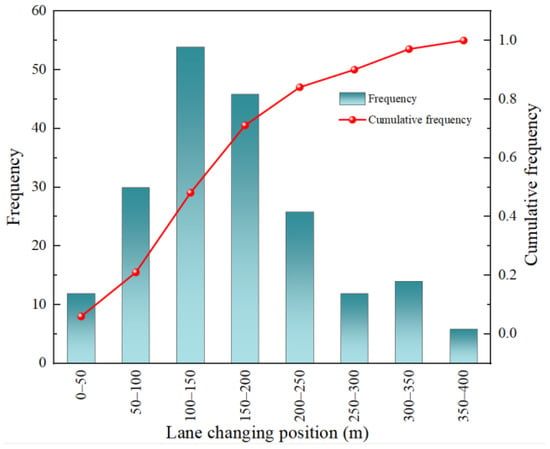
Figure 6.
Lane-change position of the exit ramp.
Based on an analysis of the figure above, the histogram of lane-changing positions closely follows a normal distribution curve. The average lane-changing position is approximately 186 m from the beginning of the transition section of the exit ramp. Notably, 50% of vehicles complete their lane change before reaching half the length of the designated lane-changing area. The highest frequency of lane-changing activity occurs within the 100–150 m range from the start of the transition section.
3. Methodology
3.1. Car-Following Model
3.1.1. Manual Car-Following Rules
In the highway exit ramp, vehicles maintain a certain safety distance as part of their follow-up behavior. To simulate this, the SUMO simulation platform (1.13.0 version) is used, embedding the Krauss car-following model for manual-driving vehicles as the longitudinal follow-up model. The Krauss model calculates a vehicle’s operating speed for the next time period based on the safety distance and subsequently updates the vehicle’s position. The following vehicle determines its speed for the next time period by considering the current speed and the distance to the vehicle ahead. This distance must satisfy the condition given in Equation (1):
where represents the distance traveled by the following vehicle in the next time period at its current operating speed; represents the distance required for the following vehicle to perform emergency braking in the next time period; and is the current distance between the following vehicle and the vehicle in front.
The equality sign denotes the maximum speed adopted by the following vehicle at the current time to avoid a collision with the vehicle ahead, i.e., the safe speed. The Krauss model uses an iteration time of 1 s for position updates, recalculating the safe speed at each iteration. Based on Equation (1), the formula for the safe speed can be expressed as Equation (2):
where represents the safe speed of the following vehicle; is the current running speed of the following vehicle; is the distance between the following vehicle and the vehicle in front; is the running speed of the vehicle in front; denotes the maximum deceleration of the vehicle in front; is the reaction time of the driver of the vehicle in front; and v denotes the current vehicle speed.
In the Krauss car-following model, the operating speed of the following vehicle in the next time period must be less than or equal to the safe speed to avoid a collision. To determine the operating speed of the following vehicle in the next time period, the vehicle position update strategy can be expressed as Equations (3)–(6):
where is the current operating speed of the following vehicle; is the maximum acceleration of the following vehicle; is the current maximum speed limit of the road; is the safe speed of the following vehicle; is the desired operating speed of the following vehicle; represents the operating speed deviation caused by the driver’s operational variability in a manual-driving vehicle; the parameter was always chosen to be 0.4 for the calculations presented here; is the operating speed for the following vehicle in the next time period, which is randomly selected within ~; denotes a random number between and ; denotes the position of the following vehicle in the next time period; and denotes the current vehicle location.
3.1.2. Car-Following Model for Automated Vehicles
In this paper, the longitudinal following behavior of automated vehicles on highway exit ramps was simulated using a constant headway strategy. The ACC/CACC (Adaptive Cruise Control/Cooperative Adaptive Cruise Control) following model was selected as the longitudinal simulation model for automated vehicles. This model can capture the characteristic behavior of automated vehicles maintaining a consistent following distance [35].
The ACC/CACC following model simplifies the vehicle spacing regulation control, which is achieved through the speed difference between the following vehicle and the vehicle ahead. This model determines the next longitudinal speed of the vehicle, allowing for the position update of the following vehicle. By applying the vehicle spacing regulation strategy, the difference between the real-time distance and the desired constant headway time distance is minimized, thereby maintaining the following state and enabling the position update. This can be expressed by Equation (7):
where is the difference between the real-time headway and the specified headway between the following vehicle i and the vehicle in front; is the current position of the vehicle in front; is the current position of the following vehicle; is the current speed of the following vehicle; is the current headway, typically set to 0.6 s; and is the coefficient of imperfection of the driver.
The operating speed of the vehicle in the next step is determined based on the vehicles’ headway time difference, as expressed by Equation (8):
where is the running speed of the following vehicle in the next simulation step; is the running speed of the following vehicle in the current simulation step; is the weight of the headway error, typically set to 0.45; and is the differential weight of the headway error, typically set to 0.25.
3.2. Vehicle Lateral Lane-Change Modeling
3.2.1. Lane-Change Rules for Manual-Driving Vehicles
The default LC2013 lane-changing model in the SUMO simulation platform comprehensively and accurately captures the lane-changing intentions of manual-driving vehicles, particularly at exit ramps. This model simulates how a driver evaluates lane-changing intentions and executes corresponding lane-change behaviors. Therefore, in this study, the LC2013 lane-changing model was selected as the lateral lane-changing model for manual-driving vehicles at highway exit ramps, and its implementation was carried out using the SUMO simulation software.
The default LC2013 lane-changing model in the SUMO simulation platform generates lane-changing intentions based on the driver’s assessment of the lane-changing conditions. The model simulates the driver’s judgment of these conditions, calculates the required transverse traveling distance for the lane change, and compares the distances to determine the shortest longitudinal distance necessary for the lane change. This can be mathematically expressed by Equation (9):
where is the shortest lateral change distance at a given time; is the running speed of the vehicle at a given time; and are the scale factor; and is the length of the vehicle.
3.2.2. Lane-Change Rules for Automated Vehicles
In this study, the lane-changing behavior of automated vehicles on highway exit ramps was simulated through the development of a game-theoretic lane-changing strategy model, which was resolved using the Nash equilibrium [36]. According to the principles of Nash equilibrium, all vehicles participating in the game adopt an optimal strategy within the strategy combination. Specifically, the lane-changing process of an automated vehicle on the exit ramp is modeled as a strategic interaction between the lane-changing vehicle and the following vehicle. This interaction is framed as a non-cooperative pure-strategy game, where the optimal lane-changing strategy is determined by solving the game using the benefit matrix and benefit function, as outlined in the previous section.
Upon the automated vehicle’s initiation of a lane change at the motorway exit ramp, the vehicle’s on-board systems collect real-time traffic data from the surrounding environment. Using this information, the vehicle’s upper-level control system assesses the conditions necessary for a safe lane change. The system then computes the potential lane-changing gain. Provided that sufficient safety and efficiency thresholds are met, the lower-level control system executes the lane-change maneuver. The specific steps involved in the lane-changing process are illustrated in Figure 7.
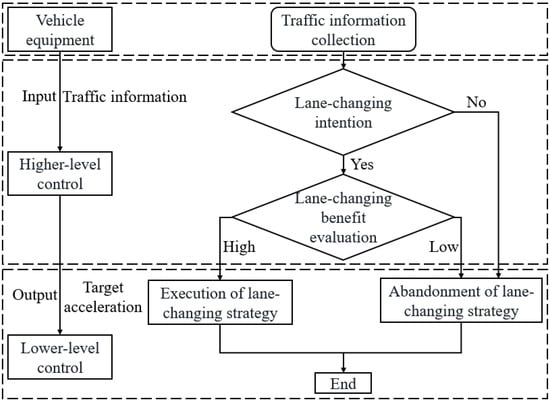
Figure 7.
Automated-vehicle lane-change process at highway exit ramps.
3.3. Model Construction
In this study, the TraCI (Traffic Control Interface) toolkit was utilized to connect with the traffic control interface and facilitate the simulation process. The vehicle module within the software was employed to obtain real-time traffic information from the surrounding environment. Specifically, the getTime function in the simulation module was used to retrieve the current simulation time, while the getIDList function was used to collect the IDs of all calibrated automated vehicles within the road network. The traffic state information for both automated and manual-driving vehicles was then obtained through various get functions, depending on the specific vehicle states. These data were encapsulated into a list for storage. Additionally, the subscribeContext function in the vehicle module was used to subscribe to vehicle information within a defined range, with the subscription variable being the ID of nearby vehicles. Once the list of all vehicles was returned in a beacon message, it was stored for further analysis. This process allowed for the efficient collection and interaction of traffic data between vehicles within the simulation.
To facilitate information interaction and gather surrounding road traffic data, automated vehicles rely on the operating rules of both manual-driving and automated vehicles. Using the python (3.8 version) toolkit, the simulation module in the vehicle module was employed to implement a game-based lane-changing strategy for automated vehicles. The simulation was executed on a Linux platform, where the Krauss vehicle-following model, the ACC/CACC vehicle-following model, and the LC2013 lane-changing model were invoked. The parameters of both automated and manual-driving vehicles—specifically, those related to vehicle following and lane-changing behaviors—were calibrated [37,38]. These parameter settings are detailed in Table 1.

Table 1.
Simulation-model parameters.
3.3.1. Macro-Parameters
Macro traffic flow parameters view traffic flow as a whole, describing the whole traffic flow operation state from a macroscopic point of view. For the exit ramp of highway under heterogeneous traffic flow environment, the macro traffic flow parameter can intuitively show the change rule of traffic flow after infiltrating a certain proportion of self-driving vehicles. Flow, speed and density are the three major macroscopic traffic flow parameters, and with the three major traffic flow related to the capacity and vehicle operation acceleration, running time. Traffic density reflects the concentration of vehicles along a road, typically expressed as the number of vehicles per unit length of a lane. This can be represented mathematically by Equation (10):
where represents the traffic density, is for traffic flow on a single lane, and is the average speed of vehicles between zones.
3.3.2. Micro-Parameters
Microscopic traffic flow parameters to a single vehicle as a research object, describing a single vehicle operation and the interaction between vehicles. For highway exit ramps under heterogeneous traffic flow environment, the microscopic traffic flow parameters can reflect the mutual change law in the operation process of individual vehicles after infiltration of autonomous vehicles, which can be expressed by the headspace and headtime, lane-change time and rate, and conflict number and rate. Specific descriptions are shown in Table 2.

Table 2.
Micro-Parameters.
3.3.3. Simulation-Model Validation Parameters
The validity of the simulation model was assessed by comparing and analyzing the differences between field measurements and simulation outputs. To ensure representativeness and accessibility, the average section speed and traffic volume were selected as key evaluation indicators. The simulation was conducted using measured data as the baseline, and the resulting simulation data were analyzed. Model validity was tested through the relative deviation of section speeds and a significance test of the traffic volume, enabling a rigorous evaluation of the simulation model’s accuracy. Specific descriptions are shown in Table 3.

Table 3.
Simulation-Model Validation Parameters.
3.4. Integrated Evaluation Model
The operation of heterogeneous traffic flows on motorway exit ramps incurs certain operational costs. This paper builds on the integrated cost evaluation model proposed by Wang et al. for assessing various control strategies of automated vehicles [39]. Considering that this study focuses on analyzing and evaluating the adaptability of highway exit ramps in heterogeneous traffic flow environments, the safe and efficient operation of heterogeneous traffic at exit ramps is primarily determined by two key aspects: longitudinal following behavior and lateral lane-changing behavior. Building upon the previously established seven cost factors, this study refines the comprehensive cost evaluation model by determining five key cost components: safety cost, equilibrium cost, control cost, efficiency cost, and lane-changing cost. The safety cost reflects the overall safety level of heterogeneous traffic flows on the freeway exit ramp. The equalization cost accounts for the need for vehicles to maintain a safe following distance while adjusting their speed to match the preceding vehicle, ensuring speed harmonization within the traffic stream. The control cost quantifies the acceleration and deceleration efforts required by vehicles while following and changing lanes, capturing the control adjustments needed for a smooth traffic flow. The efficiency cost represents the difference between the actual travel time of all vehicles passing through the freeway exit ramp and the theoretical travel time under free-flow conditions, indicating the overall operational efficiency. The lane-changing cost characterizes the frequency and complexity of lane-changing maneuvers among heterogeneous traffic flows on the freeway exit ramp, reflecting the impact of lane-changing behavior on traffic stability.
The integrated cost evaluation model quantifies the operational cost required for heterogeneous traffic flows to function efficiently at a motorway exit ramp. A lower value of this cost indicates reduced resource consumption and better adaptability of the traffic flow, while a higher value suggests poorer adaptability and a greater operational cost. The hierarchical analysis method was also used to calibrate the various cost weighting coefficients using the data analysis software SPSSAU. The finalized formula for the integrated cost evaluation model can be expressed as Equation (16):
where , , , , and represent the safety cost function, equilibrium cost function, control cost function, efficiency cost function, and lane-changing cost function, respectively, and , , , , and are the weight coefficients for each of these five cost parameters, all of which are greater than zero.
4. Simulation Experiment Design and Analysis
4.1. Simulation of Basic Scene Construction
4.1.1. Calibration of Simulation Parameters
(1) Road design parameters
Based on field investigations and aerial video data, combined with real-time map analysis and road base information, key parameters, such as the exit ramp design, the number of mainline lanes, the number of ramp lanes, lane widths, and the length of each section, were gathered. The specific values for these parameters are presented in Table 4.

Table 4.
Exit ramp road design parameters.
(2) Traffic vehicles and routing parameters
Based on field investigations and aerial video data, the traffic volume at the exit ramp was 2520 pcu/h for the mainline and 978 pcu/h for the ramp. The respective speeds were 24.6 m/s for the mainline and 22.5 m/s for the ramp. According to real-vehicle test data from related studies [37,38] and the measured results of this study, the parameters of the exit ramp heterogeneous traffic flow simulation model were determined. This includes key vehicle parameters, such as the length of self-driving and manually driven vehicles, maximum acceleration, maximum deceleration, and minimum headway. All vehicles in the model were considered as passenger cars, and the traffic flow model was based on the constructed heterogeneous traffic flow simulation framework. For detailed parameter values, see Table 5.

Table 5.
Traffic flow model.
The road network file and traffic flow data were integrated into a configuration file (*.sumo.cfg.xml). The simulation duration was set to 3600 s, and the simulation was executed by invoking the configuration file via the sumo-gui.exe tool.
4.1.2. Acquisition of Simulation Results
Lane-area detectors were configured to collect various traffic parameters, including vehicle flow, running speed, travel time, lane-change frequency, and conflict occurrences. The resulting data were outputted into *.xml file format.
4.1.3. Model Validation
Without the inclusion of self-driving vehicles, a simulation was conducted using the SUMO software, and 30% of the survey data were selected as validity verification data. The simulation duration was set to 3600 s (1 h) and was repeated five times to obtain the average simulated running speed of vehicles in the middle section of the auxiliary lanes. The actual running speed in this section was recorded as 24.6 m/s. The detailed simulation results are presented in Table 6.

Table 6.
Simulated average speed.
The relative deviation between the simulated and actual section speeds was calculated and found to be within the acceptable tolerance range. The simulated average unit hourly traffic volume for vehicles in the middle section of the auxiliary lane is presented in Table 7 below.

Table 7.
Simulated average unit hourly traffic volume.
4.2. Simulation Programme Design
This study proposes three experimental scenarios to investigate the impact of automated vehicles on traffic flows. Test 1 did not account for automated vehicles, with the experimental deceleration lane length for the exit ramp ranging from 150 m to 250 m, using 5 m increments. Other road traffic conditions remained unchanged, resulting in a total of 21 experimental groups. Test 2 considered the presence of automated vehicles, simulating traffic flows with varying proportions of automated vehicles. A comprehensive cost analysis was conducted to evaluate the adaptability of heterogeneous traffic flows under these conditions. The deceleration lane length was fixed at 180 m, with the automated vehicles’ penetration ratio starting at 0% and increasing in 10% increments. A total of 11 experimental groups were conducted under these settings, while all other conditions were held constant. Test 3 explored the combined effects of automated vehicles’ penetration and deceleration lane length on traffic flow adaptability. The deceleration lane length varied between 150 m and 250 m in 5 m increments, and the automated vehicles’ penetration ratio started at 0% and increased in 10% increments. This test involved a total of 231 experimental groups, with all other road traffic conditions unchanged. The detailed experimental design for all three scenarios is presented in Table 8.

Table 8.
Experiment tests.
4.3. Adaptation Analysis
4.3.1. Different Deceleration Lane Lengths
Test 1 used the current road traffic data as the baseline for simulation. It generated vehicle performance metrics, including running speed, acceleration, lane changes, travel time, and conflict occurrences, under existing traffic conditions. Additionally, it calculated the various operational costs incurred by the vehicles, with the safety cost being the highest, accounting for 32.38%, and the control cost being the lowest, at only 5.05%. Additionally, the efficiency and lane-change costs represent significant portions, accounting for 22.46% and 22.71%, respectively. Under the condition that the total traffic volume, exit ramp design parameters, and other factors remained unchanged, the deceleration lane length of the exit ramp varied between 150 m and 250 m in 5 m increments. Through simulations, data on the vehicle running speed, acceleration, lane changes, travel time, and conflict occurrences were collected for different deceleration lane lengths. The single and total costs incurred by vehicles under these road conditions were calculated, and the composition of each cost, along with the overall comprehensive cost, is presented in Figure 8.
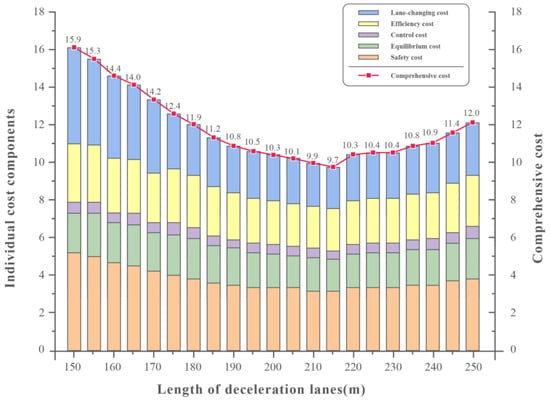
Figure 8.
Comprehensive costs.
As shown in Figure 8, in the absence of automated vehicles, the total vehicle operation cost decreases initially and then increases as the deceleration lane length increases. The comprehensive cost reaches its minimum when the deceleration lane length is 215 m, showing a reduction of approximately 2.2% compared to the current deceleration lane length of 180 m. Among the individual costs, the safety cost accounts for the largest proportion, while the control cost remains the smallest. Additionally, when the deceleration lane length is between 150 m and 170 m, the lane-changing cost is relatively high. At a deceleration lane length of 215 m, all costs show a decrease compared to the current cost for a 180 m lane. These results suggest that under the current traffic conditions, the motorway exit ramp exhibits a degree of maladaptation.
4.3.2. Different Penetration Percentages of Automated Vehicles
(1) Traffic flow parameter analysis
Test 2 used current road traffic data as the baseline for simulation. It involved testing both automated and manual-driving vehicles, each following their respective lane-changing rules. The proportion of automated vehicles varied in 10% increments from 0% to 100%. The simulation measured the traffic flow rates and average speeds of automated and manual-driving vehicles across three mainline lanes (lane 1, lane 2, and lane 3) and the exit ramp. The results of the traffic flow and average speeds for different penetration ratios of automated vehicles are presented in Figure 9.
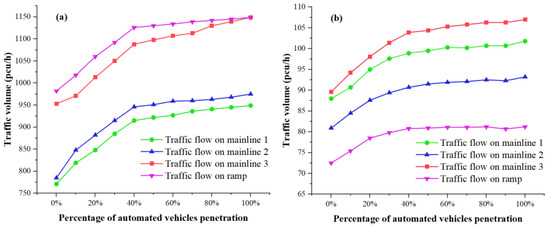
Figure 9.
Variations in traffic volume and speed with the proportion of automated vehicles in each lane: (a) traffic volume; (b) speed.
As shown in Figure 9, due to the varying functions of each lane on the motorway exit ramp, the traffic flow rate of each lane exhibits a certain degree of variability. As the penetration ratio of automated vehicles increases from 0% to 40%, the traffic flow rate of each lane gradually increases, with a faster rate of enhancement. However, when the penetration ratio rises from 40% to 100%, although the traffic flow rate continues to improve, the rate of enhancement significantly diminishes.
(2) Comprehensive cost analysis
Based on the data collected, including the vehicle running speed, acceleration, number of lane changes, travel time, and conflict occurrences under varying proportions of automated vehicles’ penetration, the individual and comprehensive costs incurred by vehicles in the road traffic environment were calculated. The composition of each cost and the overall comprehensive cost at different penetration ratios are presented in Figure 10.
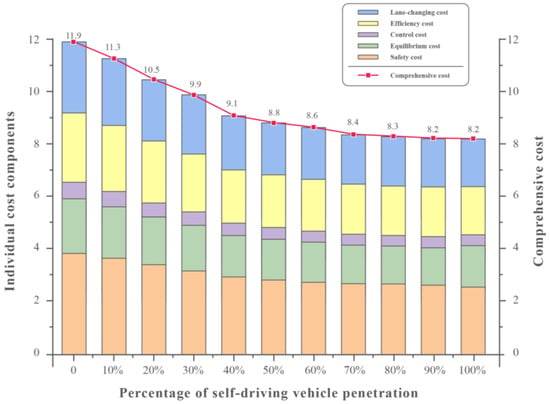
Figure 10.
Combined costs for different penetration ratios.
As shown in Figure 10, among the various costs, safety costs represent the largest proportion, while control costs account for the smallest. The remaining costs are relatively evenly distributed. As the proportion of automated vehicles’ penetration increases, the overall operational cost gradually decreases. The rate of reduction is faster when the penetration ratio rises from 0% to 40% and slower when it increases from 40% to 100%.
With the gradual penetration of varying proportions of automated vehicles into the motorway exit ramps, there is a significant improvement in the traffic flow rate, operating speed, and operational cost reduction for each lane. The most noticeable improvement occurs when the penetration ratio of automated vehicles increases up to 40%, after which the rate of improvement slows as the penetration ratio exceeds 40%. This suggests that when the penetration ratio of automated vehicles exceeds 40%, the heterogeneous traffic flow exhibits a certain degree of maladaptation to the existing road traffic conditions.
4.3.3. Lane Lengths and Penetration Ratios for Different Speed Reduction Lanes
Test 3 examined the adaptability of motorway exit ramps by adjusting both the automated vehicles’ penetration ratio and deceleration lane length. Data on the vehicle operating speed, acceleration, number of lane changes, travel time, and conflict occurrences were collected under various penetration ratios of automated vehicles. The comprehensive cost was then used to assess the adaptability of the motorway exit ramps under different combinations of automated vehicles’ penetration ratios and deceleration lane lengths. The simulation results are presented in Figure 11.
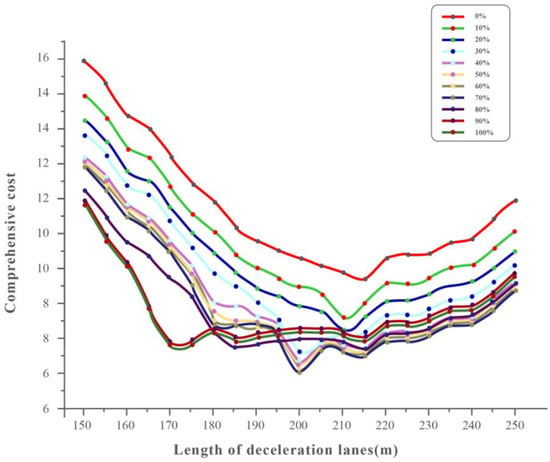
Figure 11.
Variations in combined costs for different penetration ratios and deceleration lane lengths.
As shown in Figure 11, the comprehensive cost of traffic operations initially decreases and then increases as the deceleration lane length of the motorway exit ramp varies from 150 m to 250 m. As the penetration ratio of automated vehicles increases, the comprehensive cost exhibits an overall decreasing trend. When the automated vehicles’ penetration ratio is 0%, the lowest comprehensive cost occurs at a deceleration lane length of 215 m, showing better adaptability of traffic flow on the exit ramp. At penetration ratios of 10% and 20%, the lowest comprehensive cost is also observed at a deceleration lane length of 215 m. For penetration ratios of 30%, 40%, 50%, and 60%, the lowest comprehensive cost is achieved with a deceleration lane length of 200 m. At higher penetration ratios of 70% and 80%, the minimum comprehensive cost is found at 185 m, while for 90% and 100% penetration, the lowest cost occurs at 170 m. It can be observed that for higher penetration ratios, the best adaptability occurs at a deceleration lane length of 200 m. Compared to the current length of 185 m, the 200 m deceleration lane length offers the best overall adaptability for the exit ramp. Therefore, it is recommended that the deceleration lane length be set to 200 m for optimal performance.
5. Conclusions
In this paper, a simulation model for heterogeneous traffic flows was developed based on an analysis of the current road traffic characteristics of a motorway exit ramp. The adaptability of heterogeneous traffic flows was evaluated using a simulation framework constructed with the SUMO simulation software. An example analysis was conducted to assess the adaptability of the traffic flow at the exit ramp under various conditions. The main conclusions are as follows:
(1) Based on a qualitative analysis of vehicle operation rules, the Krauss following model was chosen as a longitudinal following model for manual-driving vehicles, while the ACC/CACC vehicle following model was selected for automated vehicles. The LC2013 lane-changing model was used for manual-driving vehicles, and the game-theoretic lane-changing model was employed for automated vehicles. The parameters of these traffic flow models were calibrated, and a heterogeneous traffic flow simulation model for the highway exit ramp was constructed using the SUMO simulation software.
(2) A set of macro- and micro-parameters was introduced to evaluate the traffic flow. The safety cost, equilibrium cost, control cost, efficiency cost, and lane-changing cost were identified as key evaluation indicators. A hierarchical analysis method was used to determine the weight coefficients of each cost, allowing for the construction of a comprehensive cost evaluation model for heterogeneous traffic flows.
(3) A simulation test for the highway exit ramp was developed, with the proportion of automated vehicle penetration and deceleration lane length as the key variables. The results indicate that under current conditions with no automated vehicles, a deceleration lane length of 215 m provides better traffic flow adaptability compared to the current length of 180 m. As the proportion of automated vehicles penetrates the traffic flow, a certain degree of maladaptation is observed when the penetration ratio exceeds 40%. Finally, when the deceleration lane length is adjusted to 200 m, the heterogeneous traffic flow exhibits the best adaptability at the exit ramp.
(4) In determining the lane-following and lane-changing models for automated vehicles, this study conducted a qualitative analysis based on the operating rules of automated vehicles and relevant research data. As automated driving technology continues to mature, future research can incorporate a quantitative analysis using real-world measured data. The heterogeneous traffic flow simulation scenario for the highway exit ramp was built using the SUMO simulation software, with this study focusing solely on passenger cars. However, in real-world exit ramps, large and medium-sized passenger and freight vehicles also significantly impact traffic operations. Future research should consider the adaptability of exit ramps under heterogeneous traffic flows involving different vehicle types.
Author Contributions
Conceptualization, Z.Z.; methodology, Z.Z.; software, Z.N.; validation, Y.L. (Yichen Liu); formal analysis, Y.L. (Yan Li); investigation, Z.N.; resources, Y.L. (Yichen Liu); data curation, Z.Z.; writing—original draft preparation, Y.L. (Yan Li); writing—review and editing, Z.Z.; visualization, Y.L. (Yan Li); supervision, Z.N.; project administration, Z.Z.; funding acquisition, Z.N. All authors have read and agreed to the published version of the manuscript.
Funding
This research was funded by the National Natural Science Foundation of China, grant number U2333216.
Institutional Review Board Statement
Not applicable.
Informed Consent Statement
Not applicable.
Data Availability Statement
The data presented in this study are available on request from the corresponding author.
Conflicts of Interest
Author Yichen Liu was employed by the XPCC Construction & Engineering (Group) Co., Ltd. The remaining authors declare that the research was conducted in the absence of any commercial or financial relationships that could be construed as a potential conflict of interest.
References
- Zahabi, M.; Machado, P.; Lau, M.Y.; Deng, Y.; Pankok, C.; Hummer, J.; Rasdorf, W.; Kaber, D.B. Driver performance and attention allocation in use of logo signs on freeway exit ramps. Appl. Ergon. 2017, 65, 70–80. [Google Scholar] [CrossRef] [PubMed]
- Dong, C.; Wang, H.; Li, Y.; Wang, W.; Zhang, Z. Route Control Strategies for Autonomous Vehicles Exiting to Off-Ramps. IEEE Trans. Intell. Transp. Syst. 2020, 21, 3104–3116. [Google Scholar] [CrossRef]
- Wang, T.; Wang, C.; Qian, Z. Development of a new conflict-based safety metric for freeway exit ramps. Adv. Mech. Eng. 2017, 9, 1687814017723286. [Google Scholar] [CrossRef]
- Ye, Y.; He, J.; Wang, H.; Zhang, C.; Yan, X.; Wang, C. Research on Influencing Factors of Traffic Conflicts in Freeway Diverging Area during the Maintenance Period. J. Transp. Eng. Part A-Syst. 2023, 149, 04022149. [Google Scholar] [CrossRef]
- Ngoduy, D. Effect of the car-following combinations on the instability of heterogeneous traffic flow. Transp. B-Transp. Dyn. 2015, 3, 44–58. [Google Scholar] [CrossRef]
- Huszak, A.; Simon, V.; Bokor, L.; Tizedes, L.; Pekar, A. An AI-Driven Intelligent Transportation System: Functional Architecture and Implementation. Infocommunications J. 2024, 16, 18–30. [Google Scholar] [CrossRef]
- Luo, Y.; Chen, Y.; Lu, K.; Chen, L.; Zhang, J. Modeling and analysis of heterogeneous traffic flow considering dynamic information flow topology and driving behavioral characteristics. Phys. A 2024, 637, 129521. [Google Scholar] [CrossRef]
- Yang, B.; Inoue, K.; Yan, Z.; Wang, Z.; Kitazaki, S.; Nakano, K. Influences of Level 2 Automated Driving on Driver Behaviors: A Comparison with Manual Driving. IEEE Trans. Intell. Transp. Syst. 2024, 25, 144–158. [Google Scholar] [CrossRef]
- Woerle, J.; Metz, B.; Othersen, I.; Baumann, M. Sleep in highly automated driving: Takeover performance after waking up. Accid. Anal. Prev. 2020, 144, 105617. [Google Scholar] [CrossRef]
- Wang, X.; Zhang, J.; Li, H.; He, Z. A mixed traffic car-following behavior model. Phys. A 2023, 632, 129299. [Google Scholar] [CrossRef]
- Luo, Y.; Chen, Y.; Lu, K.; Zhang, J.; Wang, T.; Yi, Z. Modeling and analysis of heterogeneous traffic flow with mixed regular and connected human-driven vehicles considering driver stochasticity. Int. J. Mod. Phys. C 2025, 36. [Google Scholar] [CrossRef]
- Ren, W.; Cheng, R.; Ge, H. Bifurcation analysis of a heterogeneous continuum traffic flow model. Appl. Math. Model. 2021, 94, 369–387. [Google Scholar] [CrossRef]
- Emara, S.; Elewa, A.; Wasil, O.; Moustafa, K.; Khalek, N.A.; Soliman, A.H.; Halawa, H.; ElSalamouny, M.; Daoud, R.; Amer, H.; et al. Heterogeneous ITS Architecture for Manned and Unmanned Cars in Suburban Areas. In Proceedings of the IEEE 23rd International Conference on Emerging Technologies and Factory Automation (ETFA), IEEE, Torino, Italy, 4–7 September 2018; pp. 918–925. [Google Scholar]
- Qian, Z.; Li, J.; Li, X.; Zhang, M.; Wang, H. Modeling heterogeneous traffic flow: A pragmatic approach. Transp. Res. Part B-Methodol. 2017, 99, 183–204. [Google Scholar] [CrossRef]
- Wang, T.; Cheng, R.; Wu, Y. Stability analysis of heterogeneous traffic flow influenced by memory feedback control signal. Appl. Math. Model. 2022, 109, 693–708. [Google Scholar] [CrossRef]
- Khan, M.U.; Saeed, S.; Nehdi, M.L.; Rehan, R. Macroscopic Traffic-Flow Modelling Based on Gap-Filling Behavior of Heterogeneous Traffic. Appl. Sci. 2021, 11, 4278. [Google Scholar] [CrossRef]
- Zhang, F.; Qian, Y.; Zeng, J. Characterizing Heterogeneous Traffic Flow at a Slope Bottleneck via Cellular Automaton Model. IEEE Trans. Intell. Transp. Syst. 2023, 24, 6507–6516. [Google Scholar] [CrossRef]
- Bose, A.; Ioannou, P. Mixed manual/semi-automated traffic: A macroscopic analysis. Transp. Res. Part C Emerg. Technol. 2003, 11, 439–462. [Google Scholar] [CrossRef]
- Jiang, R.; Wu, Q.-S. The adaptive cruise control vehicles in the cellular automata model. Phys. Lett. A 2006, 359, 99–102. [Google Scholar] [CrossRef]
- Yuan, Y.-M.; Jiang, R.; Hu, M.-B.; Wu, Q.-S.; Wang, R. Traffic Flow Characteristics in a Mixed Traffic System Consisting of ACC Vehicles and Manual Vehicles: A Hybrid Modelling Approach. Physica A: Statistical Mechanics and its Applications 2009, 388, 2483–2491. [Google Scholar] [CrossRef]
- Liu, Y.; Guo, J.; Taplin, J.; Wang, Y. Characteristic Analysis of Mixed Traffic Flow of Regular and Autonomous Vehicles Using Cellular Automata. J. Adv. Transp. 2017, 2017, 8142074. [Google Scholar] [CrossRef]
- Aria, E.; Olstam, J.; Schwietering, C. Investigation of Automated Vehicle Effects on Driver’s Behavior and Traffic Performance. Transportation Research Procedia 2016, 15, 761–770. [Google Scholar] [CrossRef]
- Muraro Gularte, K.H.; Javidi da Costa, J.P.; Vargas, J.A.R.; Santos da Silva, A.; Almeida Santos, G.; Wang, Y.; Alfons Muller, C.; Lipps, C.; Timoteo de Sousa Junior, R.; de Britto Vidal Filho, W.; et al. Integrating Cybersecurity in V2X: A Review of Simulation Environments. IEEE Access 2024, 12, 177946–177985. [Google Scholar] [CrossRef]
- Zhang, L.; Yan, L.; Fang, Y.; Fang, X.; Huang, X. A Machine Learning-Based Defensive Alerting System Against Reckless Driving in Vehicular Networks. IEEE Trans. Veh. Technol. 2019, 68, 12227–12238. [Google Scholar] [CrossRef]
- Hakim, B.; Sorour, S.; Hefeida, M.S.; Alasmary, W.S.; Almotairi, K.H. CCPAV: Centralized cooperative perception for autonomous vehicles using CV2X. Ad Hoc Netw. 2023, 142, 103101. [Google Scholar] [CrossRef]
- Jeong, E.; Oh, C.; Lee, S. Is vehicle automation enough to prevent crashes? Role of traffic operations in automated driving environments for traffic safety. Accid. Anal. Prev. 2017, 104, 115–124. [Google Scholar] [CrossRef]
- Guan, S.; Ma, C.; Wang, J. Traffic Flow State Analysis Considering Driver Response Time and V2V Communication Delay in Heterogeneous Traffic Environment. Sustainability 2023, 15, 8459. [Google Scholar] [CrossRef]
- Pei, Y.; Pan, S.; Wen, Y. Analysis of roadway capacity for heterogeneous traffic flows considering the degree of trust of drivers of HVs in CAVs. Phys. A 2024, 639, 129693. [Google Scholar] [CrossRef]
- Ma, X.; Hu, X.; Weber, T.; Schramm, D. Evaluation of Accuracy of Traffic Flow Generation in SUMO. Appl. Sci. 2021, 11, 2584. [Google Scholar] [CrossRef]
- Stolfi, D.H.; Alba, E. Generating realistic urban traffic flows with evolutionary techniques. Eng. Appl. Artif. Intell. 2018, 75, 36–47. [Google Scholar] [CrossRef]
- Fernandes, P.; Nunes, U. Platooning of autonomous vehicles with intervehicle communications in SUMO traffic simulator. In Proceedings of the 13th International IEEE Conference on Intelligent Transportation Systems, Funchal, Madeira Island, Portugal, 19–22 September 2010; pp. 1313–1318. [Google Scholar]
- Song, J.; Wu, Y.; Xu, Z.; Lin, X. Research on Car-Following Model Based on SUMO. In Proceedings of the IEEE 7th International Conference on Advanced Infocomm Technology (ICAIT), Fuzhou, China, 14–16 November 2014; pp. 47–55. [Google Scholar]
- Smith, D.; Djahel, S.; Murphy, J. A SUMO Based Evaluation of Road Incidents’ Impact on Traffic Congestion Level in Smart Cities. In Proceedings of the IEEE 39th Conference on Local Computer Networks Workshops (LCN Workshops), Edmonton, AB, Canada, 8–11 September 2014; pp. 702–710. [Google Scholar]
- Berrazouane, M.; Tong, K.; Solmaz, S.; Kiers, M.; Erhart, J. Analysis and Initial Observations on Varying Penetration Rates of Automated Vehicles in Mixed Traffic Flow utilizing SUMO. In Proceedings of the 8th IEEE International Conference on Connected Vehicles and Expo (IIEEE CCVE), Graz, Austria, 4–8 November 2019. [Google Scholar]
- Shladover, S.E.; Desoer, C.A.; Hedrick, J.K.; Tomizuka, M.; Walrand, J.; Zhang, W.-B.; McMahon, D.H.; Peng, H.; Sheikholeslam, S.; McKeown, N. Automated vehicle control developments in the PATH program. IEEE Trans. Veh. Technol. 1991, 40, 114–130. [Google Scholar] [CrossRef]
- Reny, P.J. Nash Equilibrium in Discontinuous Games. Annu. Rev. Econ. 2020, 12, 439–470. [Google Scholar] [CrossRef]
- Xiao, L.; Wang, M.; van Arem, B. Realistic Car-Following Models for Microscopic Simulation of Adaptive and Cooperative Adaptive Cruise Control Vehicles. Transp. Res. Rec. 2017, 2623, 1–9. [Google Scholar] [CrossRef]
- Milanes, V.; Shladover, S.E. Modeling cooperative and autonomous adaptive cruise control dynamic responses using experimental data. Transp. Res. Part C-Emerg. Technol. 2014, 48, 285–300. [Google Scholar] [CrossRef]
- Wang, M.; Hoogendoorn, S.P.; Daamen, W.; van Arem, B.; Happee, R. Game theoretic approach for predictive lane-changing and car-following control. Transp. Res. Part C-Emerg. Technol. 2015, 58, 73–92. [Google Scholar] [CrossRef]
Disclaimer/Publisher’s Note: The statements, opinions and data contained in all publications are solely those of the individual author(s) and contributor(s) and not of MDPI and/or the editor(s). MDPI and/or the editor(s) disclaim responsibility for any injury to people or property resulting from any ideas, methods, instructions or products referred to in the content. |
© 2025 by the authors. Licensee MDPI, Basel, Switzerland. This article is an open access article distributed under the terms and conditions of the Creative Commons Attribution (CC BY) license (https://creativecommons.org/licenses/by/4.0/).